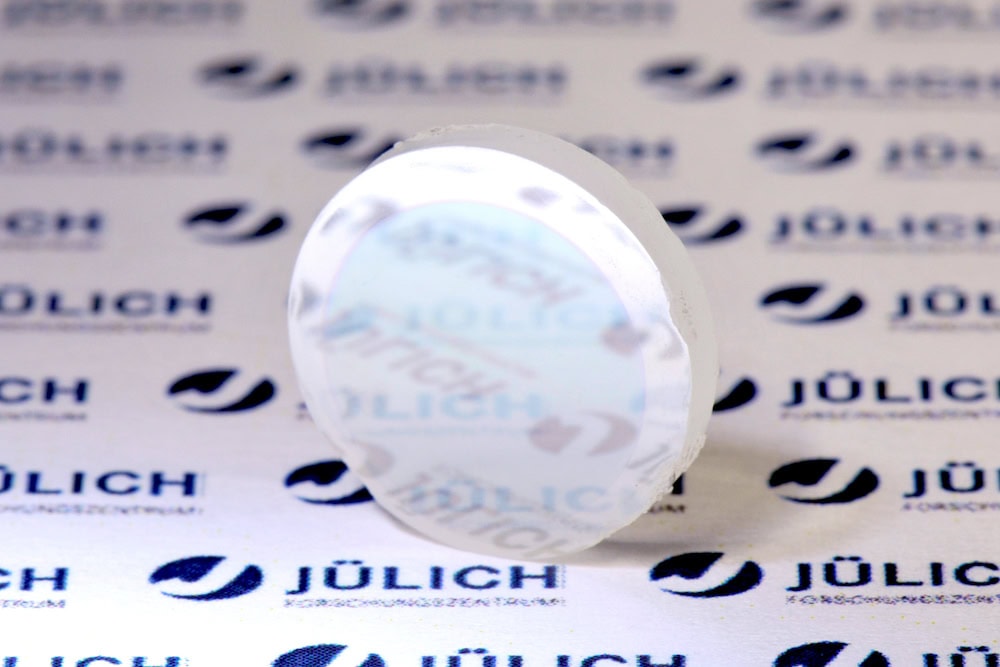
[Image above] Jülich scientists created yttria-coated transparent zirconia ceramics that demonstrated fracture toughness values far higher than tempered glass. Credit: Hiltrud Moitroux, Forschungszentrum Jülich
With a little less than two weeks left till the end of the year, let us talk about a popular topic one last time: smartphones.
The holidays regularly see a record number of phone activations and app downloads year after year (especially in 2012), and with the host of new smartphones available this winter, that trend will likely continue. What better time, then, to talk about what may be coming soon to a phone near you?
Smartphones were the focus of the December 2018 ACerS Bulletin feature article, and a recent Ceramic Tech Today post discussed the challenges of making foldable smartphones.
One challenge to making foldable smartphones is the cover glass. Cover glasses must be tough to sustain repeated falls onto a hard floor and random encounters with car keys; however, a tough glass is a rigid glass, and rigid glasses cannot bend or fold without fractures or breakage. For foldable smartphones, that means saying bye-bye to Gorilla Glass, Corning’s popular material for smartphone cover glass.
For non-folding phones, however, Gorilla Glass continues to hold first place for cover glass material due to its strength and durability. And it might continue to do so…if we look only at glass for cover glass material. New work out of Germany points to a polycrystalline competitor for amorphous covers.
Transparent ceramics are inorganic, nonmetallic polycrystalline materials that provide a promising alternative to traditional glass technologies. Already, transparent ceramics are replacing glass in lasers due to their high refractive index. However, transparent ceramics’ optical transparency is traditionally less than glass, and the ceramics do not reach their full strength potential because of microstructure defects, which limits their ability to function well as a cover glass.
“Even the tiniest irregularities in the surface can lead to cracks, which then expand under certain stresses—bending, for example—causing the component to fracture,” says Olivier Guillon, ACerS member and head of Materials Synthesis and Processing at Jülich’s Institute of Energy and Climate Research, in a press release.
The goal to minimize microstructure defects drove Guillon and a Jülich group led by Martin Bram to demonstrate feasibility of a promising concept: stabilizing transparent ceramic surfaces through functional coatings.
“Our goal was to transfer the concept of strengthened glass to transparent ceramics for the first time,” says Guillon in the press release. “Similar to the idea behind Gorilla Glass, which is widely used in mobile phones, we aimed to stabilize the surface of transparent ceramics by applying a thin coating of another material.”
However, instead of strengthening their material through ion-exchange—the process used to strengthen Gorilla Glass—Guillon and his group used a thermal treatment to strengthen their material. In the glass world, ion-exchange and tempering are the two primary methods for strengthening glass.
In a recent paper, the group heated the surface of a transparent zirconia ceramic and then used vapor deposition to coat it with an ultrathin layer of yttria, less than a micrometer thick. They then annealed the material in argon atmosphere at 1450°C (2642°F) for 1–12 hours and quenched in a furnace having relatively rapid natural cooling, approximately 10°C/min (50°F/min) down to 800°C (1472°F).
The yttria reduced light reflections on the transparent zirconia surface, but more importantly, the yttria helped generate a high compressive stress on the surface during cooling.
“Due to the different thermal properties of the two materials—zirconia expands more than yttria when heated, and shrinks more when cooled—a high degree of compressive stress is generated in the coating during cooling,” explains Bram in the press release. “This stress causes the surface of the component to compress, effectively preventing cracking. As a result, the component is more stable and its surface more resistant to scratches.”
The researchers showed their method doubles or even triples the fracture toughness of transparent ceramics, achieving fracture toughness values far higher than tempered glass. Additionally, because the technique can be applied as an after-treatment to finished workpieces and only takes a few hours to perform, it is suitable for industrial mass production. “Our results clearly indicate that the technique can be applied to real-life applications,” note the researchers in the press release.
Though Gorilla Glass may not relinquish its first-place title just yet, the competition from non-glass competitors is definitely heating up!
The paper, published in Scientific Reports, is “Increasing Fracture Toughness and Transmittance of Transparent Ceramics using Functional Low-Thermal Expansion Coatings” (DOI: 10.1038/s41598-018-33919-5).
Author
Lisa McDonald
CTT Categories
- Basic Science
- Optics


